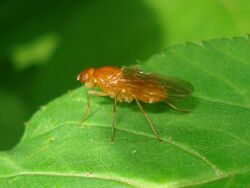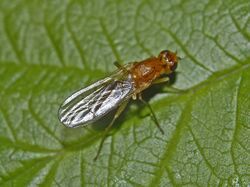Biology:Psila fimetaria
| Psila fimetaria | |
|---|---|

| |
| Psila fimetaria. Side view | |
| Scientific classification | |
| Domain: | Eukaryota |
| Kingdom: | Animalia |
| Phylum: | Arthropoda |
| Class: | Insecta |
| Order: | Diptera |
| Family: | Psilidae |
| Genus: | Psila |
| Species: | P. fimetaria
|
| Binomial name | |
| Psila fimetaria (Linnaeus, 1761)
| |
| Synonyms | |
| |
Psila fimetaria is a species of fly, a member of the family Psilidae.[1]
Distribution
This species is present in part of Europe (Belgium, Great Britain, Czech Republic, Denmark , Germany , Hungary, Italy, Lithuania, Slovakia, Ireland),[2] in Russia and in North Africa.[3]
Habitat
These common flies inhabit woods and forests, bushes and herbs, especially damp places,[4] lush vegetation, hedge rows and amongst the crops.[5][6]
Description
Psila fimetaria can reach a length of 7.7–8.8 millimetres (0.30–0.35 in).[4][5] Body is basically yellow-red, covered with short black bristles. On the abdomen tergites are sometimes distinctly browned. Head is red, with a black ocellar triangle. Eyes are large and reniformes. Palps are yellow. Antennae are short, red, with the third subconical segment a little thicker and black at the base. Arista shows a longer pubescence. Legs are long, yellowish, slightly dark at the tip of tarsi. Wings are transparent, a little yellowed at the anterior edge.[4][7]
As with all species of the genus Psila, the males have no thickened femora on the hind legs and the females have only a simple ovipositor.
This species is very similar to Psila merdari, but in P. fimetaria the hairs beneath the second antennal joint are longer and the third antennal joint is darkened on the outer side at the base of the arista.[6]
Biology
Adults can be found from May to September.[4][5][6] Imago are not very active Larvae are phytophagous and oligophagous. They develop in the roots, bulbs and non-woody stems of plants, especially on Carex.[5][6]
Bibliography
- Joachim Haupt, Hiroko Haupt: Fliegen und Mücken. Beobachtung, Lebensweise. 1. Auflage. Naturbuch-Verlag, Jena und Stuttgart 1995, ISBN:3-89440-278-4.
- Pape T. & Thompson F.C. (eds) - Systema Dipterorum
References
- ↑ BioLib
- ↑ Fauna europaea
- ↑ Catalogue of life
- ↑ 4.0 4.1 4.2 4.3 Séguy, E. (1934) Diptères: Brachycères. II. Muscidae acalypterae, Scatophagidae. Paris: Éditions Faune de France 28 Bibliotheque Virtuelle Numerique pdf
- ↑ 5.0 5.1 5.2 5.3 J.K. Lindsey Commanster
- ↑ 6.0 6.1 6.2 6.3 Nature Spot
- ↑ Bei-Bienko, G.Y. & Steyskal, G.C. (1988) Keys to the Insects of the European Part of the USSR, Volume V: Diptera and Siphonaptera, Parts I, II. Amerind Publishing Co., New Delhi. ISBN:81-205-0080-6 ISBN:81-205-0081-4
Wikidata ☰ Q2115817 entry
 |


